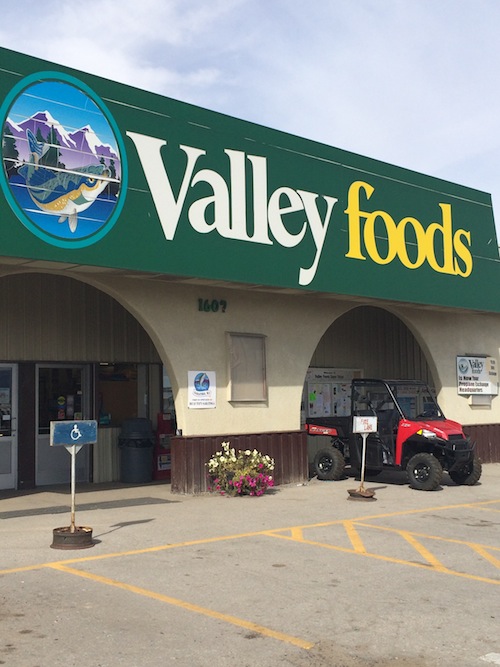Last updated on October 26th, 2015 at 08:53 am
by Kristen Cloud/staff writer
Tim Lamprecht has more experience in the food industry that most. This year, in fact, marks his 50th year in the business. His career has spanned from “carryout boy” to supplier representative to today being the owner and GM of Valley Foods and Liquor in Saratoga—located about 7,000 feet in elevation between two mountain ranges in south Wyoming, just northwest of Cheyenne.
Saratoga is where the North Platte River originates and is “just a beautiful area, a large tourist community,” according to Lamprecht. “Our weather is just about perfect.”
“We have a lot of hunting, fishing and hiking opportunities,” Lamprecht tells The Shelby Report of Saratoga, and Valley Foods, which flies the IGA banner, is a reflection of the community.
The 20,000-s.f. store features dozens of mounts, from a big grizzly bear to moose, deer, antelope and elk. Lamprecht estimates there’s at least six to seven dozen mounts showcased in the store.

“Wyoming is a great hunting state,” he says. “We have a lot of hunters who come into the store, and they just really rave on our mounts here.”
Lamprecht, originally of Aurora, Nebraska, started in retail as a 14-year-old carryout boy in 1965, “like a lot of us did back in the day,” he says. He left the retail side of the business in 1985 and began working out of the Affiliated Foods Midwest warehouse in Norfolk, Nebraska, as a retail representative. He couldn’t stay away from the retail end of the business, however, and in 2000 purchased the store in Saratoga.
“The previous owner of the store had passed away, unfortunately,” Lamprecht says. “His family—it was a little bit too much for them to run. …One of the first things that we did, we recognized that the perishables were pretty weak so we came in and focused on primarily just a USDA choice beef program. During the summer months, we also age our meats an extra 30 days.”
In addition to differentiating itself through its perishable departments, Valley Foods boasts a 4,000-s.f liquor store, carrying more than 750 varieties of wine—among the largest wine selections in the area—and focuses on craft beers.
Valley Foods has an A+ Better Business Bureau rating and also has been recognized as an IGA Five Star Retailer for six consecutive years.
“(IGA) comes in, and they judge us on different criteria as far as fresh, rotation, variety, friendliness, cleanliness, all those things,” Lamprecht says. “We take that very seriously. That’s a great feather in our hat, so to speak.”

 Lamprecht also credits IGA for giving his store and staff the tools they need to operate successfully, particularly when it comes to online training.
Lamprecht also credits IGA for giving his store and staff the tools they need to operate successfully, particularly when it comes to online training.
“The online training is critical for us,” he says. “They really have given us the tools to help us be successful. The quality of the private label goods is phenomenal. I used to work for private label, so I’m very knowledgable in that area, but (IGA is) very successful in that regard, too.”
Like most independents, Valley Foods faces it share of competition. In addition to a Walmart and King Soopers (a Kroger banner), there’s also a Family Dollar within a short drive of Lamprecht’s market.
Valley Foods, which has about 30 employees, continues to focus on what it does best, though.
“When Walmart came into town, we only lost about 2 percent, because we really focus on our perishable departments—produce, meat, deli, dairy,” Lamprecht says.
Busy tourist season bodes well for state
The summer season is typically a busy one in Wyoming, and the 2015 season has been especially good for the state in terms of tourism.
At Valley Foods, tourism increases its volume around 30 percent, according to Lamprecht.

Jim Robinson, principal economist for the state, tells The Shelby Report that the state’s tourism numbers “have been charting really well, and they still continue to do that.
“You’ve got that direct link with lodging and restaurants, the retail trade—more people in the state during the summer visiting and buying, staying at hotels—I think all that bodes well for (the food retail business).”
Wyoming, unlike states like California, has has a mild wildfire season this year, too.
“The last couple of years, fires started kind of early in Colorado and Wyoming; people were reading about these things in May and June and then making plans to avoid, in some cases, coming out to the West because of the wildfires,” Robinson says. “This year, we had a lot of rain back in May because of the Rocky Mountain area, and that really took away that threat. Then, of course, the gasoline prices were much lower this past summer than they were a year ago. Those were things that really helped out.”
Those positive tourism numbers have increased the state’s sales tax revenue, according to Mary Lou Chapman, president of the Rocky Mountain Food Industry Association (RMFIA), which represents grocers in both Wyoming and Colorado.

And that’s a good thing, she notes, since, overall, revenues are down considerably—mostly due to the decline in oil and mineral prices. Oil/gas is the Cowboy State’s No. 1 industry.
Robinson points out that the state began seeing layoffs in the mining sector, particularly related to oil, around March and April
“Oil primarily is where the slowdown was,” he says. “We’ve lost about 4,000 jobs, approximately, in a year-over-year comparison, compared to where we were last year.”
The good news is those numbers seem to have leveled off of late.
“But we don’t necessarily see rehiring or anything like that taking place,” he adds. “We’ve kind of reached a new equilibrium; it’s a little bit lower than where we were last year. We have less money and activity in the state, but to kind of offset that, we had a really good tourist season, which will continue probably through October before we start getting cold weather.”
The preliminary unemployment rate for August in Wyoming is 4.0 percent.
Another sector currently seeing improvement in Wyoming is building and construction, according to Robinson.
He mentions that there’s currently a flurry of activity in southeast Wyoming, especially at the University of Wyoming where there are a number of projects under way.
“That aspect of construction, where you’re talking about building, has been doing very well compared to last year,” he says. “The other part of construction that relates to, say, highway construction—that’s down compared to last year just because there’s been less funding available for that.”
The gas tax increase two years ago was helpful, according to Chapman, but the state’s road systems are “always a concern.”
“Wyoming does a good job on their roads, but there’s a lot of distance between places in Wyoming. So we always have to keep our eyes open on that,” she tells The Shelby Report. “We all got behind (the increase) and we do think that’s been a help, but again, it’s one of those issues that states just really have a hard time staying ahead of, especially if you’re a state that has up-and-down weather—highs and lows in weather—that tends to tear up roads; and a lot of trucks going across your roads, which we obviously have in Wyoming because of the distance and because of the oil industry and the coal industry.”
Wyoming is ‘pro-business’, but there are always issues to address
Wyoming has long been known as a “pro-business” state.
As Chapman says, “…The legislature and the governor’s office is always focused on what can we do to make the business climate better or best for our businesses. They always remember who brings the money to programs.”
The state’s legislature alternates between hosting a full session and a budget session. A full session convened this year, and the food industry came out of it pretty unscathed.
Among the issues addressed:
• House Bill 24: State minimum wage increase—This bill would have increased the state’s minimum wage from $5.15 to $9 per hour, or 175 percent, and from $2.13 to $5 per hour for tipped employees, or 235 percent. The RMFIA opposed this bill, which was defeated in the House Revenue Committee by a vote of 1-8.
Chapman expects this issue to come up again in the near future.
Wyoming currently has the lowest minimum wage in the country. Chapman reveals, though, that “most of us in business, most of us representing business, generally say that our members and most of the businesses in the state are paying comparable to the federal minimum wage anyway, so they don’t have to be mandated by the government to tell them what to pay… Some of the legislators who supported the increase did so because of potential image concerns with the state.”
• HB 173: Tobacco tax increase—This bill would have increased the tobacco tax on cigarettes by 65 cents per pack, or 108 percent, to $1.25 per pack and increased the state excise tax on other tobacco products (cigars, chew, etc.) by 120 percent. The RMFIA opposed this bill, which failed in the House Revenue Committee.
Wyoming’s tobacco tax is still a bit lower than most states, including its border states, according to Chapman, who anticipates seeing a similar increase proposal in the future. The RMFIA would oppose any tax increase on tobacco.
“As far as we’re concerned, when you add the taxes, it tends to decline the revenue because more people will make other decisions, like going across state lines or buying on the internet or possibly stop using…When adult smokers shift their purchases across state lines or to other outlets like the internet, it obviously harms retailers and it doesn’t help the state. Then, of course, we also know that cigarette taxes are another one of those regressive taxes that negatively affects lower-income adult smokers more than anyone else. Those are the people who are affected the most and, in all honesty, rarely does it impact younger smokers; they find other ways to get what they want. We will oppose any tax increases, but we’re interested in seeing what other options they have, especially on the idea of taking a look at (prevention and cessation) programs that were paid for with the tobacco (settlement) funds,” meaning cutting or altering these programs.
State lawmakers support federal GMO-labeling
On a topic that has divided much of the nation—the labeling of foods that contain genetically modified organisms, or GMOs—Wyoming is taking a stand with the side creating a uniform federal policy by passing a resolution to that effect in committee. In other words, the resolution calls on Congress to pass pending legislation specifying that only federal agencies—not individual states—may regulate GMO foods. The committee expects the measure to head to the full legislature early next year.
*Editor’s note: This 2015 Wyoming Market Profile also appears in the November print edition of The Shelby Report of the West.






